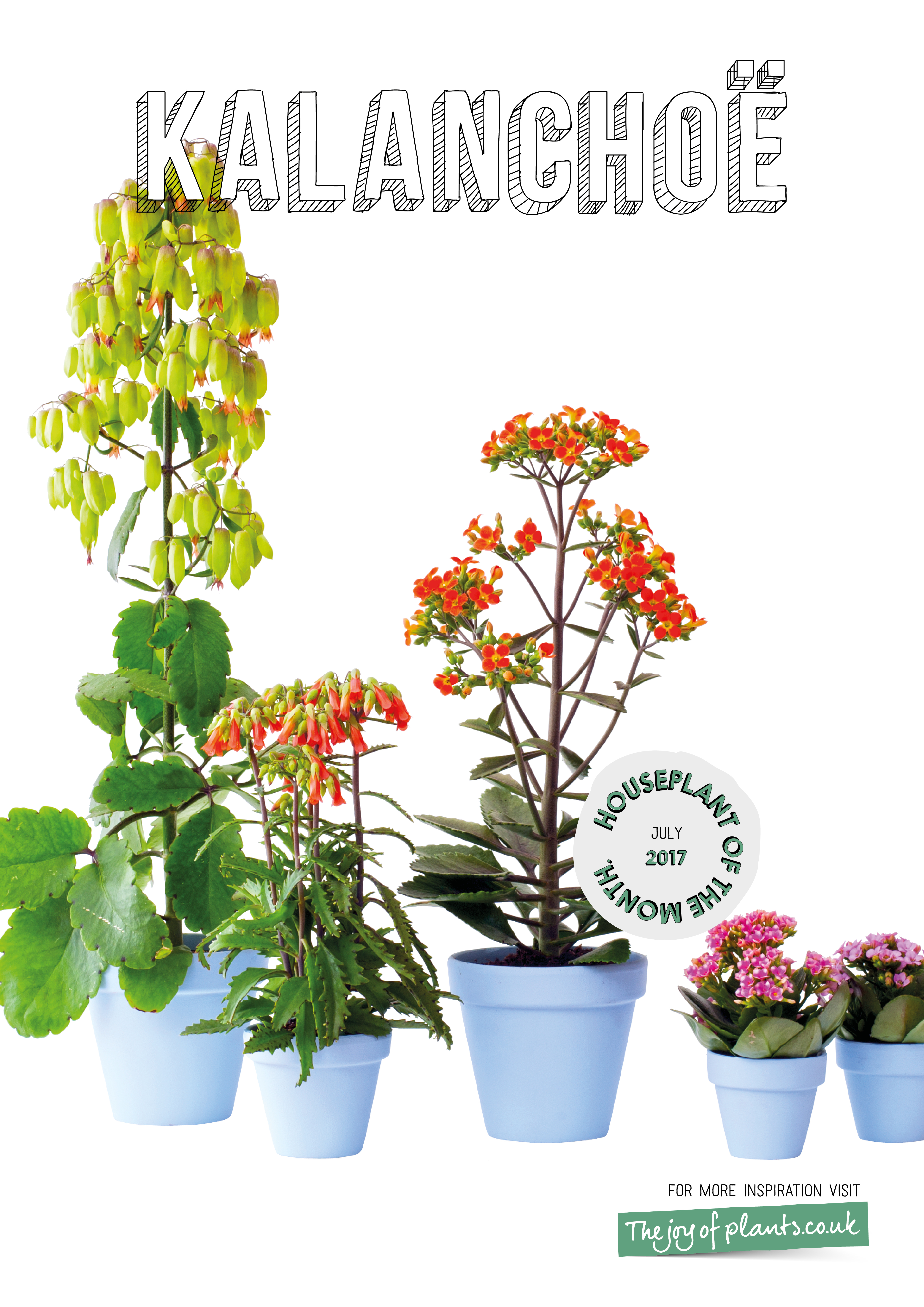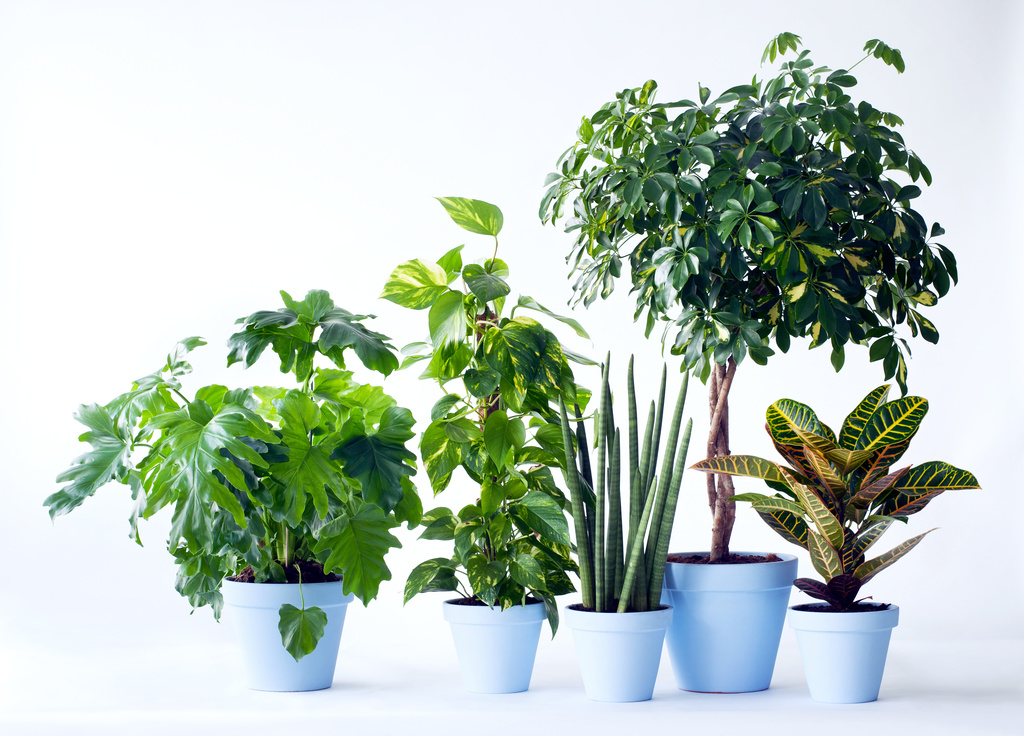Kalanchoe - Houseplant off the Month - July
July 2017: Kalanchoe Houseplant of the Month
The story of Kalanchoe
Magnificent forms, easy to look after and keeps looking good for a long time: these are the characteristics that make Kalanchoe a star amongst the flowering houseplants. An asset for enhancing the interior, but also a popular bedding, balcony or patio plant in spring and summer which can tolerate both sun and shade and blooms endlessly.
Magnificent forms, easy to look after and keeps looking good for a long time: these are the characteristics that make Kalanchoe a star amongst the flowering houseplants. An asset for enhancing the interior, but also a popular bedding, balcony or patio plant in spring and summer which can tolerate both sun and shade and blooms endlessly.
Origin
Kalanchoe is a member of the Crassulaceae family, which also includes many other succulents such as Crassula and Echeveria. The most common flowering variety is Kalanchoe blossfeldiana, which can have both single and double flowers. There are also Kalanchoes that stand out because of their beautiful bell-shaped flowers or leaves. The plants grow in Madagascar, south and east Africa, south-east Asia and China. The name is derived from that latter country: Kalan Chau was ‘latinised’ into Kalanchoe.
Kalanchoe is a member of the Crassulaceae family, which also includes many other succulents such as Crassula and Echeveria. The most common flowering variety is Kalanchoe blossfeldiana, which can have both single and double flowers. There are also Kalanchoes that stand out because of their beautiful bell-shaped flowers or leaves. The plants grow in Madagascar, south and east Africa, south-east Asia and China. The name is derived from that latter country: Kalan Chau was ‘latinised’ into Kalanchoe.
What to look for when buying Kalanchoe
Kalanchoe is a short day plant. That means that the plants form buds when the days are less than 12 hours long. Growers have the opportunity to play with light and dark. Hence short and long days can be reproduced in the greenhouse in order to get the plant to flower all year round.
Kalanchoe is a short day plant. That means that the plants form buds when the days are less than 12 hours long. Growers have the opportunity to play with light and dark. Hence short and long days can be reproduced in the greenhouse in order to get the plant to flower all year round.
Buying factors
- When buying Kalanchoe, the pot size (they’re available from mini through to large bowls), the diameter and thickness of the plant, the number of buds and the ripeness all play a role. The flowers must still be in bud, but showing some colour.
- Check that the plant is free of pests and diseases. When the flowers or the foliage are damaged or flawed, this is often the result of shipping or storage. Wilted flowers or yellow leaves indicate that the plant is not in top condition.
- if too much moisture is left between the leaves for a long time as a result of condensation, botrytis can occur. There are virtually no other pests or diseases present on Kalanchoe during the sale phase.
- Make sure the plants get enough light during shipping and at the point of sale in order to prevent the flower stems from stretching.
- Kalanchoe cannot cope with temperatures below 12°C . You should therefore leave the plant in the sleeve during the shipping and storage phase in order to avoid cold damage.
- There is also a risk of damage when Kalanchoe is placed outdoors. Keep an eye on the temperature.
 Choice of range
Choice of rangeKalanchoe Blossfeldiana is the most common species in the range. They’re usually not sold by cultivar, but by colour or in mixed trays. The plants come in many different colours: red, orange, yellow, green, white, pink, lilac, salmon and bicoloured varieties. The flower can be single (e.g. Calanday) or double-flowered (e.g. Calandiva or Rosalina). The size the flowers can also vary - there are increasing numbers of varieties with larger flowers on the market. The Bells series offers alternative flower shapes. These Kalanchoes have sprays of pale green hollow cushions from which bell-shaped flowers emerge. Mirabella has much smaller flowers and is particularly sold as a patio plant. Alongside flowering Kalanchoes, there’s also an attractive range of foliage Kalanchoes with beautiful thick leaves. The best-known is Kalanchoe thyrisflora.
Care tips for consumers
- The thick fleshy leaves - flowering Kalanchoe is a succulent - mean that the plant needs little care and is therefore also suitable with people who don’t have green fingers.
- Kalanchoe prefers a light to sunny spot both indoors and outdoors, provided that the temperature remains above 12°C.
- The plant stores moisture in the thick leaves; watering once a week is enough. Too much water is definitely to be avoided: it’s better for the soil to be a little too dry than much too wet.
- Give plant food once a fortnight for rich and lengthy flowering. Flowering plants consume more energy and other nutrients than green plants.
- Carefully remove wilted flowers, whilst avoiding damaging new buds.
Display tips for Kalanchoe
Kalanchoe works well in a display based on colour, is suitable for kokedama and can be lucratively used for special seasonal occasions: red for Valentine’s Day, red and white Christmas, yellow for Easter, pink for Mother’s Day and orange for the autumn. The mini varieties work very well in indoor gardening arrangements and table pieces, particularly combined with foliage Kalanchoes, Echeveria or Crassula. Their minis are also a suitable gift the children, as an easy first plant in the playroom. Kalanchoe is long-lasting in containers and baskets, a budget-friendly floral solution for the hospitality and commercial sector, and an ideal plant gift for students. One of its strengths is that Kalanchoe can cope with sunlight and can therefore furnish a whole windowsill with colour. Many reasons on why these plants make excellent gifts.
Kalanchoe works well in a display based on colour, is suitable for kokedama and can be lucratively used for special seasonal occasions: red for Valentine’s Day, red and white Christmas, yellow for Easter, pink for Mother’s Day and orange for the autumn. The mini varieties work very well in indoor gardening arrangements and table pieces, particularly combined with foliage Kalanchoes, Echeveria or Crassula. Their minis are also a suitable gift the children, as an easy first plant in the playroom. Kalanchoe is long-lasting in containers and baskets, a budget-friendly floral solution for the hospitality and commercial sector, and an ideal plant gift for students. One of its strengths is that Kalanchoe can cope with sunlight and can therefore furnish a whole windowsill with colour. Many reasons on why these plants make excellent gifts.
Ask us to see what colours we have in stock these week or for a special occasion we can buy in to your special request, say corporate colours for an open day.
We can source all of these plants through the season just ask us for your requirements. We can also source a wide range of pots to compliment each plant or for a striking look bright and colourful pots of all shapes and sizes. Whether for a long term display or for a one off event we can source, supply and set up so you don't have to. A care service can also be supplied if needed.
Thank you to Thejoyofplants.co.uk. and https://www.flowercouncil.co.uk for the above information.


 Choice of range
Choice of range 







